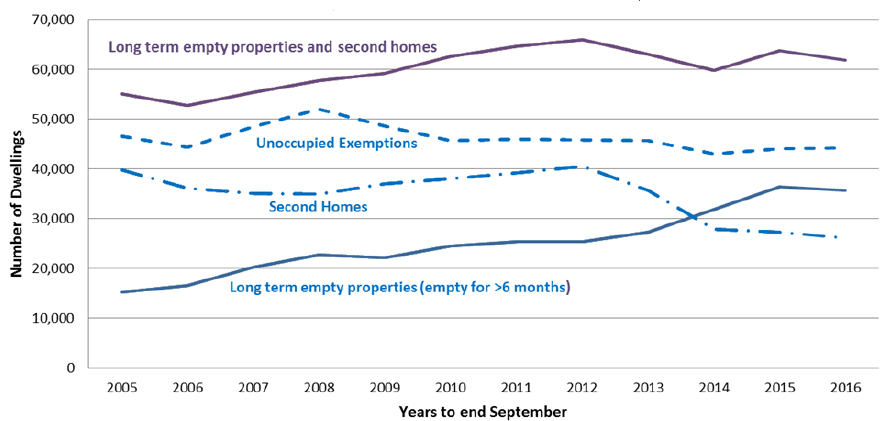Housing statistics: quarterly update, December 2016
Statistical information on recent trends in housing.
Long Term Empty Properties and Second Homes
Councils classify some properties in their area as long term empty, unoccupied, or second homes for the purposes of calculating council tax liabilities. These statuses impact on the council tax through exemptions for unoccupied properties, discounts for second homes and some long term empty properties, or a levy for some long term empty properties. As a result information on the numbers of such properties is sourced from council tax statistics. It is collected annually from local authorities and is available for:
- Unoccupied Exemptions: generally properties which are empty and unfurnished for less than 6 months and exempt from paying council tax.
- Long Term Empty Properties: properties which have been empty for more than 6 months and are liable for council tax. This includes properties empty for 12 months or more and which may be subject to an additional levy of up to 100% according to local authority policy.
- Second Homes: homes which are furnished and lived in for at least 25 days in a 12 month period but not as someone's main residence. They are entitled to a council tax discount of between 10% and 50%. In 2015/16, all local authorities had opted for a 10% discount on second homes. As of April 2017, local authorities will have the option to remove the council tax discount on second homes.
Empty properties are of particular interest as they can help increase the supply of occupied housing in Scotland when brought back into use.
From 1st April 2013 local authorities gained the discretionary power to remove the council tax discount associated with long term empty properties or to set a council tax increase of 100% on certain properties which have been empty for 12 months or more. These changes, along with associated improvements in the data held by local authorities, have led to the reclassification of a number of properties between the long term empty and second home categories. Some local authorities have also reported issues with categorising properties on their management information systems which may have impacted on the figures. This should be kept in mind when comparing the numbers in recent years.
The latest figures, as at September 2016, show that there were 26,140 second homes, 44,296 unoccupied exemptions which have generally been empty and unfurnished for less than 6 months, and 35,725 long term empty properties that had been empty for more than 6 months. Of those that had been empty for more than 6 months, over half (20,784 or 58%) had been empty for over 12 months, and of those 10,897 had a council tax discount below 10% or a council tax increase applied under the new powers described above.
Chart 14: Long Term Empty Properties, Second Homes and Unoccupied Exemptions, 2005 to 2016

Chart 14 above shows that, since 2005, the number of long term empty properties has generally been on the rise, having more than doubled over this period, however some of the rises in 2013 to 2015 will be due to the reclassification of some properties in the light of the new powers described above. There has been a slight decrease between 2015 and 2016. The number of second homes has remained more steady until recently, with the reductions in 2013 to 2016 also likely to be at least partly due to reclassification. The number of unoccupied exemptions has remained relatively steady since 2005, aside from a slight increase in 2008.
After a decrease between 2005 and 2006 the total number of long term empty properties and second homes increased from 52,823 in 2006 to 66,053 in 2012 (13,230 dwellings or 25%). It has since fallen to 59,763 in 2014 before increasing in 2016 to 61,865 (with a slight peak of 63,736 in 2015). There has been a decrease in the last year of 1,871 properties (3%). However, this change over time should be interpreted with some caution; increases and decreases can be caused in part by reclassification exercises which local authorities carry out from time to time, or issues with management information systems, rather than real changes in numbers of properties.
Contact
There is a problem
Thanks for your feedback